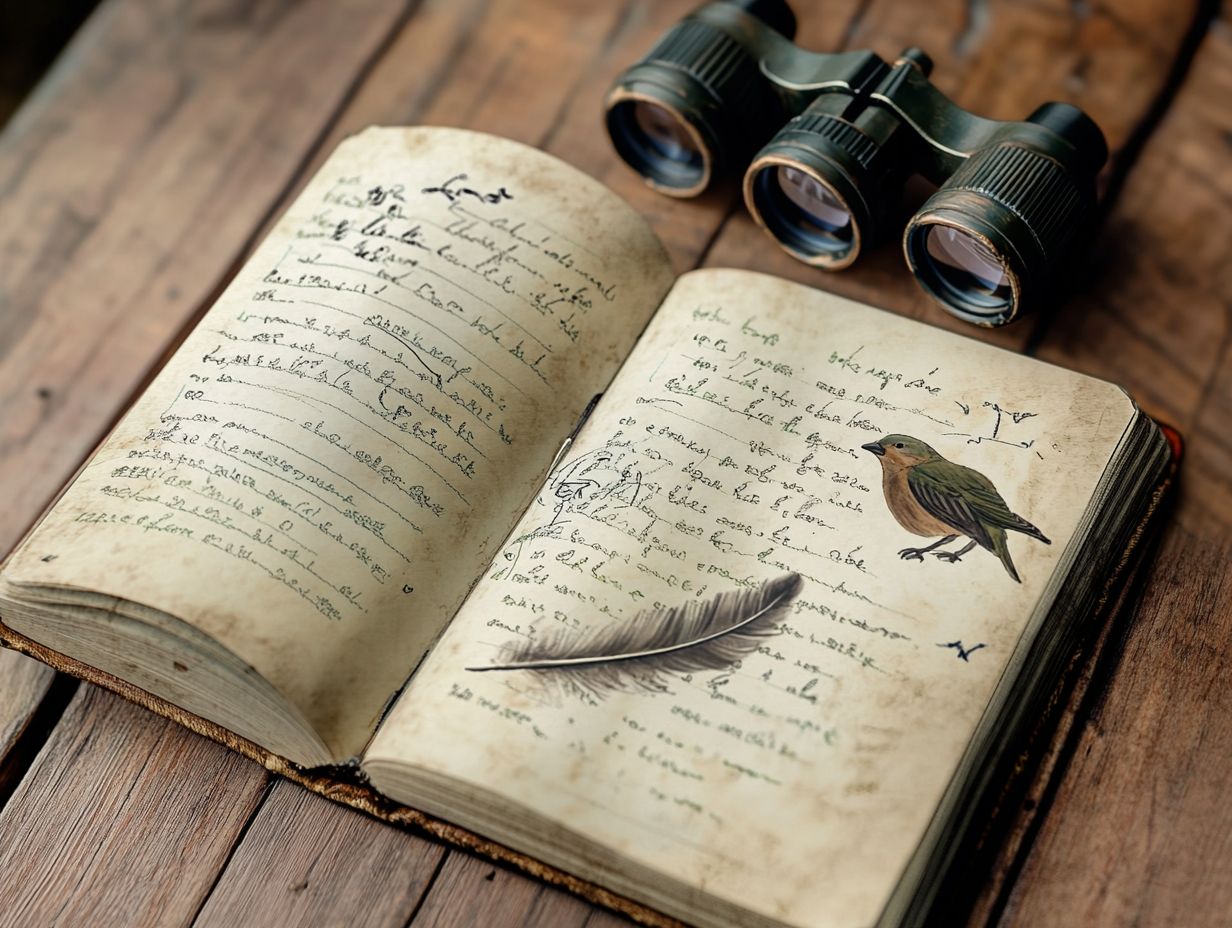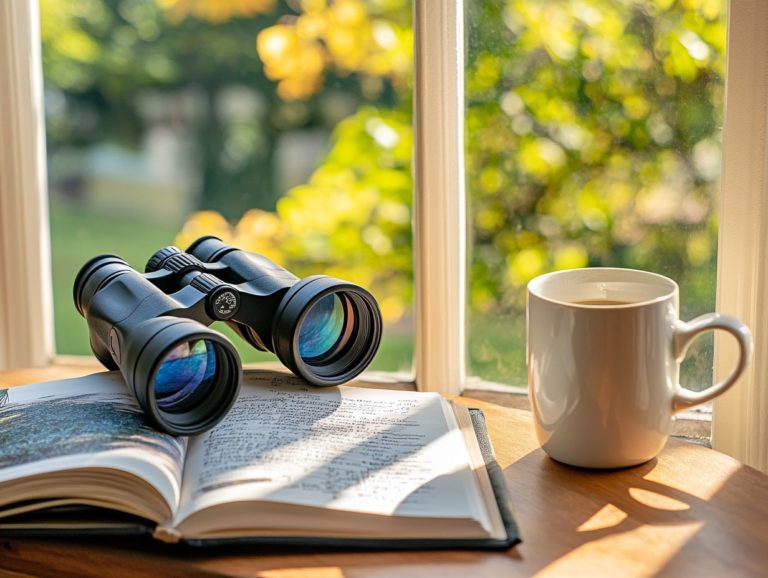What is the Best Way to Keep a Bird Diary?
Keeping a bird diary is a truly rewarding endeavor that deepens your connection with nature and offers valuable insights for both enthusiasts and researchers alike.
This guide delves into the many benefits of maintaining a bird diary, from tracking your sightings to making meaningful contributions to citizen science. It covers how to select the perfect diary, what essential information to include, and practical tips for staying organized and effectively recording your observations.
Get ready to dive into the amazing world of birds! This guide will motivate you to capture your birdwatching adventures meaningfully.
Contents
- Key Takeaways:
- The Importance of Keeping a Bird Diary
- Choosing the Right Type of Diary
- What to Include in Your Bird Diary
- Tips for Maintaining a Bird Diary
- Using Your Bird Diary for Research
- How to Contribute to Citizen Science Efforts
- Frequently Asked Questions
- What is the Best Way to Keep a Bird Diary?
- How often should I update my bird diary?
- Can I use a digital format for my bird diary, such as eBird or Project FeederWatch?
- Is it important to include artistic photos or sketches in my bird diary?
- Should I record the location of my bird sightings in my diary, especially specific regions like Michigan, Illinois, Wisconsin, Virginia, or Georgia?
- What other information should I include in my bird diary, especially regarding species like Kirtland’s Warbler, Greater Prairie Chicken, Blue Jay, cardinal, chickadee, goldfinch, mourning dove, Anhinga, Snowy Egret, and Purple Gallinule?
Key Takeaways:

- Track birds to provide valuable data on behavior and populations.
- Choose a bird diary by considering size, layout, and features.
- Record essential details like dates, locations, and species.
The Importance of Keeping a Bird Diary
Keeping a bird diary is more than just a hobby. It s an important activity for bird lovers and researchers. This practice also promotes a mindful exploration of local habitats and ecosystems while playing a crucial role in conservation efforts.
By documenting your observations, sketches, and photos, you can track your birdwatching experiences through the seasons spring, summer, fall, and winter.
This thoughtful practice fosters a profound sense of well-being, encouraging you to connect deeply with the natural world around you.
Benefits for Bird Enthusiasts and Researchers
As a bird enthusiast or researcher, keeping a bird diary offers great benefits that go well beyond simple record-keeping. It elevates your personal well-being and supports essential conservation efforts.
Engaging in this mindful practice can lead to significant improvements in your mental health. Simply spending time observing local avian species, whether it s the vibrant American Robin or the striking Bald Eagle, can promote relaxation and diminish stress.
Consistent diary entries enhance your observational skills, allowing you to gain a deeper understanding of bird behavior and migration patterns. This collective knowledge, grounded in citizen-reported data, proves crucial for numerous studies that highlight the impacts of climate change on species like the Eastern Bluebird.
Ultimately, these activities not only foster your personal growth but also play a vital role in community-led conservation initiatives.
Choosing the Right Type of Diary
Choosing the right type of diary is essential. It can enhance your birdwatching experience by making it easier to record observations and track sightings.
You have a plethora of options available, ranging from straightforward notebooks to intricate field journals, each thoughtfully designed for birdwatching aficionados. Whether you re detailing plumage, behavior, or habitat, the ideal diary can significantly enrich your birdwatching journey.
Options and Features to Consider

When selecting a birdwatching diary, consider which options and features suit your style. Look for spaces for sketches, photographs, and detailed observations to capture your experiences.
Choose a diary with weather-resistant pages for jotting down notes in any conditions. This keeps your memories safe, even with unpredictable weather.
Look for dedicated spaces for personal reflections. This lets you express your thoughts about your nature adventures. All these elements enhance your birdwatching journey, fostering a deeper connection to the environment and the captivating birds you encounter.
What to Include in Your Bird Diary
In crafting a comprehensive bird diary, it s essential to include specific information that enriches your observations and elevates your birdwatching experience. This means capturing vital elements like species details, sighting dates, weather conditions, and individual behaviors.
By doing so, you enable a deeper understanding of each species and their habitats. Diligently recording these details enhances your personal enjoyment and contributes to a larger narrative that supports conservation efforts.
Essential Information to Track
Tracking essential details in your bird diary boosts your understanding of the avian species you encounter. Including observations on behavior, weather conditions, and specific dates sets a foundation for a richer understanding.
When you meticulously log species names, you enhance your grasp of local biodiversity while also contributing invaluable data for scientific studies. Detailing behavioral notes like feeding habits, mating rituals, and migratory patterns allows you to paint a clearer picture of each species’ ecological role.
Noting environmental factors such as temperature, humidity, and habitat types enriches your entries and helps you identify trends or changes over time. This practice deepens your personal insights and aligns with broader conservation goals, providing critical information that supports organizations in protecting and sustaining these magnificent creatures for future generations.
Tips for Maintaining a Bird Diary
Maintaining a bird diary demands a blend of organization and precise recording techniques that enhance your ability to document observations, sketches, and photographs seamlessly. By cultivating these practices, you create a rich tapestry of your avian encounters that stands the test of time.
Organization and Recording Techniques

Effective organization and recording techniques are essential for maintaining your bird diary, ensuring that your observations are documented coherently and are easily accessible.
By implementing thematic sections based on different seasons or specific habitats, you can create a structured approach that enhances your tracking experience. For instance, consider categorizing your entries by winter migratory patterns or summer nesting habits; this allows for effortless retrieval of information later on.
Utilizing mobile apps specifically designed for birdwatching can streamline your documentation process, enabling you to record sightings instantly while on the go. Additionally, incorporating simple recording techniques like jotting down field notes or snapping quick photographs will enrich your diary and provide valuable references for your future explorations.
Using Your Bird Diary for Research
By utilizing your bird diary for research purposes, you play a crucial role in advancing conservation efforts and community-driven science projects.
Your observations transform into valuable data points, enriching broader ecological studies and making a meaningful impact on the environment.
How to Contribute to Citizen Science Efforts
Contributing to citizen science through your bird diary means sharing your observations and insights with larger research initiatives focused on conserving bird populations and their habitats.
By writing down what you see, you become an essential part of helping scientists gather critical data on bird distributions, behaviors, and environmental shifts. To get started, identify local and national citizen science projects that emphasize bird studies. Then, create or maintain your bird diary, carefully recording the date, location, species observed, and any behavioral notes.
These detailed records assist researchers in their analyses and enhance the accuracy of the data you submit. Submit your findings through the designated platforms or mobile apps to ensure your information reaches the right hands and effectively supports ongoing research efforts.
Frequently Asked Questions
What is the Best Way to Keep a Bird Diary?

The best way to keep a bird diary is to find a journal or notebook specifically designed for recording bird observations. These journals often have extra features like sections for sketching or recording bird calls.
How often should I update my bird diary?
You might update it daily, weekly, or even monthly, depending on how often you spot birds!
Can I use a digital format for my bird diary, such as eBird or Project FeederWatch?
Yes, you can use a digital app or program to keep track of your bird observations. Just make sure to regularly back up your data in case of any technical issues.
Is it important to include artistic photos or sketches in my bird diary?
Including photos or sketches can be helpful for identification purposes and adds a personal touch to your entries. However, it is not necessary; you can still keep a detailed diary without them.
Should I record the location of my bird sightings in my diary, especially specific regions like Michigan, Illinois, Wisconsin, Virginia, or Georgia?
Yes! Recording the location of your bird sightings helps track migration patterns, which are the routes birds take during seasonal changes. It also allows you to revisit areas where you have had successful observations.
What other information should I include in my bird diary, especially regarding species like Kirtland’s Warbler, Greater Prairie Chicken, Blue Jay, cardinal, chickadee, goldfinch, mourning dove, Anhinga, Snowy Egret, and Purple Gallinule?
In addition to the bird species and location, you can record the date, time of day, weather conditions, and any unique behaviors or interactions you observed. This will provide a more comprehensive record of your bird observations.






